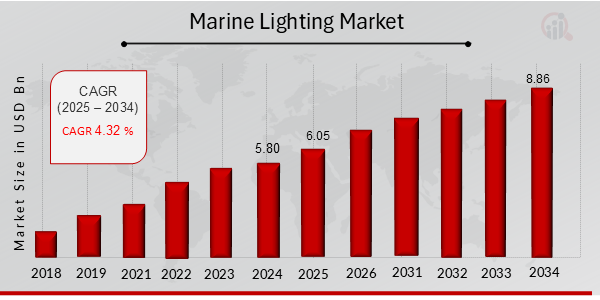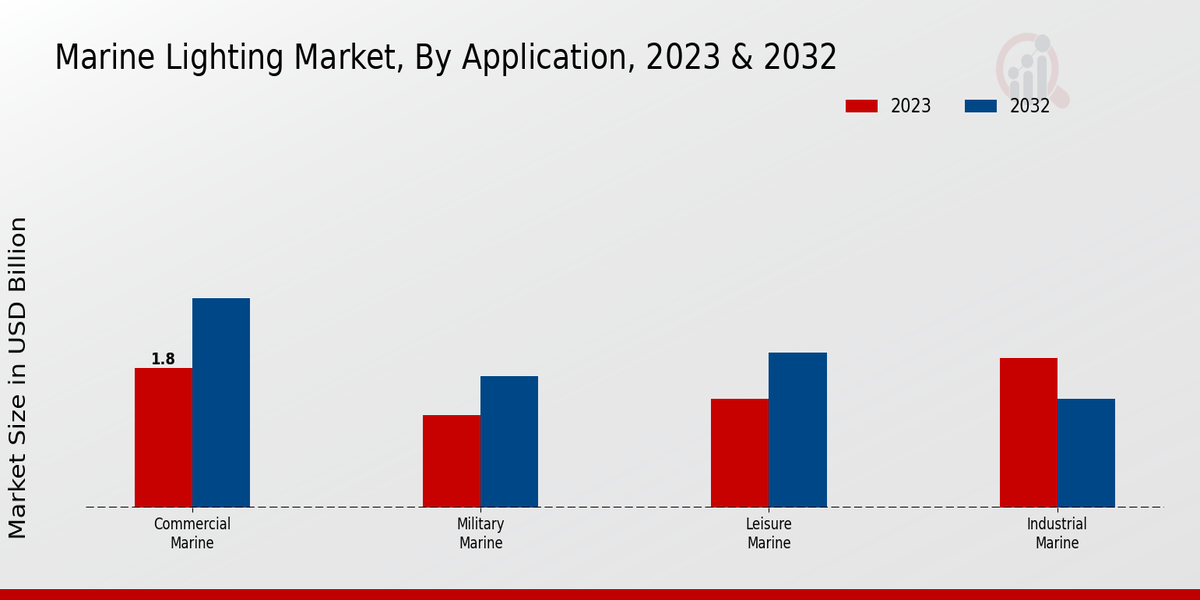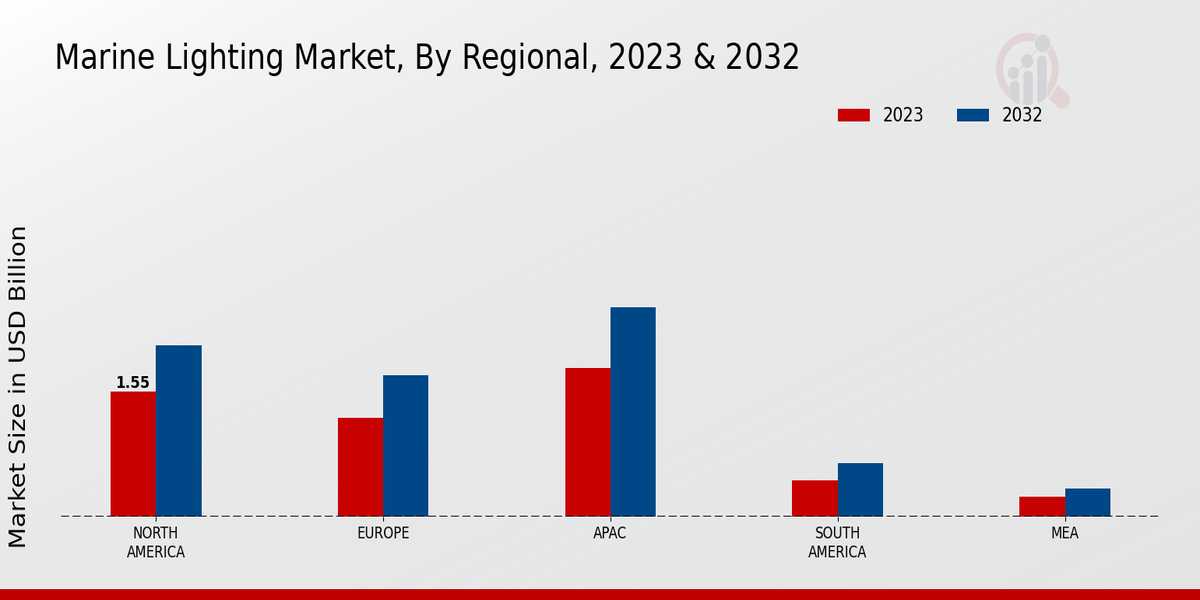Marine Lighting Market Overview
As per MRFR analysis, the Marine Lighting Market Size was estimated at 5.80 (USD Billion) in 2024. The Marine Lighting Market Industry is expected to grow from 6.05 (USD Billion) in 2025 to 8.86 (USD Billion) till 2034, at a CAGR (growth rate) is expected to be around 4.32% during the forecast period (2025 - 2034).
Key Marine Lighting Market Trends Highlighted
The Marine Lighting Market is experiencing notable growth driven by several key factors. Increased environmental regulations and a push for energy efficiency have led to a rising demand for advanced marine lighting solutions. The shift toward LED technology is notable as it offers longer lifespans and lower energy consumption compared to traditional lighting. These technologies not only reduce operational costs for marine operators but also address sustainability goals. Additionally, the expansion of the maritime industry, including commercial shipping and recreational boating, has heightened the necessity for reliable and durable lighting solutions in various marine applications.
Opportunities abound in this sector, particularly with the integration of smart technology and IoT in marine lighting systems. As vessels become more interconnected, the opportunity to develop lighting solutions that can be remotely monitored and controlled is increasing. This innovation can enhance safety and operational efficiency, providing a substantial edge for companies that invest in these advancements. Moreover, the growth of the tourism sector and the rise of leisure boating activities have expanded the potential market for decorative and functional lighting on yachts and boats.
Recently, trends indicate a growing preference for customizable lighting systems to meet specific user requirements.The focus is shifting from solely functional lighting to aesthetics and ambiance, particularly in recreational vessels. Sustainability continues to play a crucial role as consumers become more aware of the environmental impact of their choices. Innovative designs and energy-efficient solutions that comply with green standards are becoming vital for attracting more eco-conscious consumers. This evolving landscape suggests that the Marine Lighting Market will increasingly align with broader technological and environmental trends in the coming years.

Source: Primary Research, Secondary Research, MRFR Database and Analyst Review
Marine Lighting Market Drivers
Increasing Demand for Energy-Efficient Lighting Solutions
The shift towards energy-efficient lighting solutions is one of the most prominent drivers in the Marine Lighting Market Industry. With the growing awareness of sustainability and the need to reduce carbon footprints, there is a significant demand for lighting systems that not only deliver performance but also conserve energy. Marine operations, whether for recreational or commercial purposes, require robust lighting solutions that can withstand harsh marine environments while minimizing energy consumption.
Advanced technologies such as LED lighting offer effective solutions that not only meet illumination needs but also contribute to overall energy savings. The increasing adoption of LED and other energy-efficient technologies is expected to accelerate the growth of the market, given that they significantly outperform traditional lighting options in terms of longevity and maintenance costs. Furthermore, regulatory pressures from various international bodies advocating for energy-efficient practices will continue to drive demand within the Marine Lighting Market Industry.This shift not only benefits operators by reducing operating costs but also enhances environmental responsibility in maritime operations, making energy efficiency a pivotal driver in future market expansion. As more operators seek to comply with environmental standards, the transition to energy-efficient marine lighting solutions is anticipated to gain momentum, establishing a sustainable path for growth in the industry.
Technological Advancements in Marine Lighting
Technological advancements have played a crucial role in shaping the Marine Lighting Market Industry. Innovations such as smart lighting solutions, which allow for remote control and automation, are increasingly becoming popular in maritime applications. These advancements are not only enhancing the functionality of marine lighting systems but also improving safety measures in various marine operations. Enhanced features like sensors and smart controls ensure optimal performance by adjusting to environmental conditions, ensuring adequate illumination when necessary.Furthermore, the integration of IoT technologies has paved the way for smarter marine lighting solutions that can communicate and provide real-time data to operators. As technology continues to evolve, the adaptability and efficiency of marine lighting systems are expected to improve, thus propelling market growth.
Growth of the Marine Industry and Recreational Boating
The growth of the marine industry, particularly in the recreational boating segment, is driving the demand for marine lighting solutions. The rising popularity of leisure activities on water bodies is leading to an increase in the number of boats and marine vessels. Consequently, there is a growing requirement for effective and stylish lighting solutions designed for these vessels. This trend is particularly evident in the luxury boating segment, where aesthetics and functionality go hand in hand.Increased investments in marine infrastructure and the establishment of new marinas also contribute to the rising demand for advanced marine lighting products. As recreational boating continues to grow, it generates new opportunities for manufacturers in the Marine Lighting Market Industry.
Marine Lighting Market Segment Insights
Marine Lighting Market Application Insights
The Marine Lighting Market, valued at 5.33 USD Billion in 2023, showcases a diverse landscape when segmented by application. Among these applications, the Commercial Marine sector stands out with a valuation of 1.8 USD Billion in 2023, highlighting its significant contribution to the overall market landscape. This segment's growth can be attributed to the increasing demand for commercial vessels and offshore activities where effective lighting solutions are crucial for safety and operational efficiency.
Following closely, the Military Marine segment, valued at 1.2 USD Billion in 2023, plays a critical role in enhancing the operational capabilities of naval vessels.This sector emphasizes the necessity for specialized lighting that can withstand challenging conditions and aid in tactical operations. In the realm of Leisure Marine, the market reached a valuation of 1.4 USD Billion in 2023, reflecting the growing trend of recreational boating and luxury yachting, where aesthetically pleasing and functional lighting adds value to the experience.
Meanwhile, the Industrial Marine sector, valued at 1.93 USD Billion in 2023, underscores the essential need for robust lighting solutions that can operate effectively in demanding working environments, particularly in shipbuilding and maintenance operations.Together, these segments illustrate a comprehensive understanding of the Marine Lighting Market's application landscape, showcasing various driving forces, from safety regulations in commercial marine settings to the aesthetic demands in leisure boating, all fueled by a growing global marine industry. The interplay of these segments contributes to the overall market growth and opportunities, offering insights into trends and consumer preferences that are shaping the future of marine lighting solutions.

Source: Primary Research, Secondary Research, MRFR Database and Analyst Review
Marine Lighting Market Light Source Insights
The Light Source segment of the Marine Lighting Market is integral to the overall industry framework, contributing significantly to the overall market value. This segment's growth is driven by the increasing demand for energy-efficient lighting solutions and advancements in technology. LED lighting holds a dominant position due to its longevity, reduced energy consumption and minimal maintenance requirements, catering to a variety of marine applications.
Halogen lights, while less energy-efficient, are favored for their bright, natural light, enhancing visibility on boats and ships.Fluorescent lighting is also prevalent, valued for its cost-effectiveness and wide-ranging applications across marine environments. Additionally, High-Intensity Discharge (HID) lights are recognized for their exceptional brightness and are frequently employed in larger vessels for specific navigational and operational needs. Overall, the envisioned trends suggest a strong preference for innovative lighting solutions, shaping the market dynamics within the Marine Lighting Market segmentation and influencing future strategies for growth and development.
Marine Lighting Market Power Source Insights
The Power Source segment within the Marine Lighting Market reflects a growing emphasis on sustainable and efficient lighting solutions for maritime applications. Among the various power sources, solar-powered systems have gained traction owing to their eco-friendly nature, significantly reducing energy costs and environmental impact. Battery-powered lighting solutions continue to be vital for emergency and portable applications, offering flexibility and independence from traditional power sources.AC-powered systems remain popular for their robust performance and compatibility in larger marine vessels, while DC-powered solutions are favored in specific segments due to their efficiency and suitability for low-voltage applications. The Marine Lighting Market data showcases a significant shift towards integrating advanced technologies, such as LED lighting, across various power sources, enhancing both energy efficiency and lifespan, thereby contributing to the overall market growth. Various trends are driving this segment, including the push for green initiatives, changes in regulatory frameworks, and technological advancements in lighting systems that pave the way for more innovative solutions in maritime lighting.
Marine Lighting Market Installation Type Insights
The Marine Lighting Market revenue has been steadily growing, with a significant focus on the Installation Type segment, which is pivotal in shaping market dynamics. This segment can be categorized into Fixed, Portable, Underwater and Surface Mount types, each contributing uniquely to the market's landscape. Fixed lighting systems are essential for providing reliable illumination in various marine applications, ensuring safety and efficiency. Conversely, Portable marine lights have gained traction due to their versatility, being preferred for activities such as fishing and recreational boating.Underwater lighting is also prominent, enhancing both aesthetic appeal and functionality in aquatic environments, bringing a notable boost to marine life visibility and security.
Surface Mount lighting is critical for ensuring quality illumination in marine vessels, leading to improved operational efficiency and safety measures. With the rising trends toward renewable energy sources and technological advancements in LED lighting, the Marine Lighting Market segmentation is poised for continued expansion, reflecting the growing demand for effective and energy-efficient solutions in the marine sector.The market growth is driven by increasing maritime activities, safety regulations, and the continuous need for innovation in lighting technology.
Marine Lighting Market Regional Insights
The Regional segmentation of the Marine Lighting Market reveals a diverse landscape, with North America dominating the market, valued at 1.55 USD Billion in 2023 and projected to reach 2.13 USD Billion by 2032. This significant valuation reflects the region's advanced maritime infrastructure and increasing emphasis on safety regulations. Europe follows closely, with a valuation of 1.23 USD Billion in 2023, anticipated to grow to 1.76 USD Billion, driven by the region's strong focus on sustainability and energy efficiency in marine applications.
The APAC region, valued at 1.85 USD Billion in 2023 and expected to reach 2.6 USD Billion, shows robust growth fueled by rising maritime trade and investments in port development. Meanwhile, South America, with a valuation of 0.45 USD Billion, and the MEA region at 0.25 USD Billion in 2023, represent smaller shares of the market. However, their growth potential is significant, especially as maritime activities continue to expand in these areas, thereby increasing demand for efficient marine lighting solutions. Overall, the Marine Lighting Market statistics reflect a regionally diverse landscape, with varying growth drivers and opportunities across different markets.

Source: Primary Research, Secondary Research, MRFR Database and Analyst Review
Marine Lighting Market Key Players and Competitive Insights:
The Marine Lighting Market is characterized by a dynamic competitive landscape where innovation, technological advancements, and sustainability play pivotal roles in shaping the market's progression. With increasing demand for efficient and durable lighting solutions in marine applications, companies are vying for a significant share of this growing market. The competitive insights reveal that numerous players are engaged in developing specialized products tailored to meet the unique requirements of the marine environment, including waterproofing, corrosion resistance, and energy efficiency.
Factors such as regulatory compliance, technological integration, and brand reputation heavily influence strategic decisions, while partnerships and collaborations further enhance market positioning and product offerings.LED Autolamps stands out in the Marine Lighting Market due to its robust portfolio of high-quality LED lighting solutions designed specifically for marine applications. The company’s emphasis on durability and performance, reinforced by extensive research and development efforts, positions it strongly against competitors. Customers value LED Autolamps' commitment to energy efficiency, which not only enhances user experience but also contributes to sustainable practices in marine lighting.
The company's reputation for reliability and excellent customer service further strengthens its position in the market. Its keen focus on innovation enables LED Autolamps to address the evolving needs of the industry, thereby maintaining a competitive edge as it seeks to expand its market presence.Vishay Intertechnology offers a comprehensive range of advanced lighting solutions within the Marine Lighting Market, underscored by a strong commitment to quality and performance. The company is well-regarded for its innovative technologies that cater to various marine lighting requirements, enabling them to capture attention in this competitive landscape.
Vishay Intertechnology's strengths lie in its extensive experience and expertise in electronics, allowing it to develop superior products that withstand harsh marine conditions. With a global presence, the company benefits from established distribution channels and a reputation for reliability, making it a preferred choice among consumers seeking durable and efficient lighting solutions. Continuous investment in research and development helps Vishay Intertechnology to keep pace with market trends and integrate cutting-edge technology into their offerings, thereby enhancing their competitive advantage.
Key Companies in the Marine Lighting Market Include
- LED Autolamps
- Vishay Intertechnology
- Hella
- Signify
- Galadari
- Imtra
- SeaCure
- Lumens
- Cree
- SaviLED
- Bardex Corporation
- GloBrite
- Osram
- Marine Lighting Ltd
- Docklite
Marine Lighting Market Industry Developments
Recent developments in the Marine Lighting Market indicate a heightened focus on innovation, sustainability, and smart technologies. Companies such as LED Autolamps and Vishay Intertechnology are exploring advanced LED technologies to enhance energy efficiency and reduce environmental impact. Hella and Signify are incorporating IoT capabilities into their marine lighting solutions, facilitating better control and monitoring systems for marine operators.Current affairs highlight the competitive landscape, where firms like Galadari and Imtra are attempting to expand their market share through product diversification. Notably, there have been strategic mergers and acquisitions within the sector; for instance, companies such as Osram and Cree are exploring potential synergies to strengthen their positions in the marketplace.
This consolidation is helping these firms streamline operations, and leverage shared resources, which could potentially lead to enhanced product offerings and increased customer satisfaction.Moreover, the overall growth in market valuation signals a robust demand for reliable marine lighting solutions driven by increased recreational boating activities and maritime safety regulations. As a result, the demand for durable, high-performance lighting systems continues to rise among both commercial and private marine operators, significantly impacting the market dynamics.
Marine Lighting Market Segmentation Insights
Marine Lighting Market Application Outlook
- Commercial Marine
- Military Marine
- Leisure Marine
- Industrial Marine
Marine Lighting Market Light Source Outlook
- LED
- Halogen
- Fluorescent
- HID
Marine Lighting Market Power Source Outlook
- Solar Powered
- Battery Powered
- AC Powered
- DC Powered
Marine Lighting Market Installation Type Outlook
- Fixed
- Portable
- Underwater
- Surface Mount
Marine Lighting Market Regional Outlook
- North America
- Europe
- South America
- Asia Pacific
- Middle East and Africa
| Report Attribute/Metric |
Details |
|
Market Size 2024
|
5.80 (USD Billion)
|
|
Market Size 2025
|
6.05 (USD Billion)
|
|
Market Size 2034
|
8.86 (USD Billion)
|
|
Compound Annual Growth Rate (CAGR)
|
4.32% (2025 - 2034)
|
|
Report Coverage
|
Revenue Forecast, Competitive Landscape, Growth Factors, and Trends
|
|
Base Year
|
2024
|
|
Market Forecast Period
|
2025 - 2034
|
|
Historical Data
|
2019 - 2023
|
| Market Forecast Units |
USD Billion |
| Key Companies Profiled |
LED Autolamps, Vishay Intertechnology, Hella, Signify, Galadari, Imtra, SeaCure, Lumens, Cree, SaviLED, Bardex Corporation, GloBrite, Osram, Marine Lighting Ltd, Docklite |
| Segments Covered |
Application, Light Source, Power Source, Installation Type, Regional |
| Key Market Opportunities |
1. Sustainable LED lighting solutions, 2. Technological innovations in smart lighting, 3. Growing demand for energy efficiency, 4. Expansion in the marine tourism sector, 5. Increasing government regulations on safety |
| Key Market Dynamics |
1. Technological advancement, 2. Regulatory compliance, 3. Environmental sustainability, 4. Growing recreational boating, 5. Increasing demand for energy efficiency |
| Countries Covered |
North America, Europe, APAC, South America, MEA |
Frequently Asked Questions (FAQ) :
The Marine Lighting Market was expected to be valued at 8.86 USD Billion in 2034.
The expected CAGR for the Marine Lighting Market during the period from 2025 to 2034 is 4.32%.
North America is projected to have the largest market size, valued at 2.13 USD Billion in 2032.
The Commercial Marine application segment is anticipated to dominate the market, projected at 2.7 USD Billion by 2032.
Key players in the market include LED Autolamps, Hella, Signify, and Osram, among others.
The Military Marine application segment is expected to be valued at 1.7 USD Billion by 2032.
The Leisure Marine segment is expected to reach a market value of 2.0 USD Billion by 2032.
The Industrial Marine application is anticipated to be valued at 1.4 USD Billion in 2032.
The market size for South America is projected to be 0.67 USD Billion in 2032.
The expected market value in North America for 2023 is 1.55 USD Billion.

















